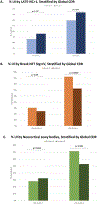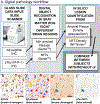Urinary Incontinence in a Community-Based Autopsy Cohort Is Associated with Limbic Predominant Age-Related TDP-43 Encephalopathy Neuropathologic Changes
- PMID: 37248909
- PMCID: PMC10618953
- DOI: 10.3233/JAD-230425
Urinary Incontinence in a Community-Based Autopsy Cohort Is Associated with Limbic Predominant Age-Related TDP-43 Encephalopathy Neuropathologic Changes
Abstract
Background: Dementia and urinary incontinence (UI) are etiologically complex clinical syndromes. Dementia and UI often occur in the same individuals, but underlying factors connecting them are incompletely understood.
Objective: Query data from a community-based autopsy series to assess pathologies that underlie UI.
Methods: Included research subjects came to autopsy from the University of Kentucky Alzheimer's Disease Research Center longitudinal cohort. A total of 368 research volunteers met inclusion criteria for this cross-sectional study. The average age at death was 85.3 years and the average number of annual clinic visits was 5.2 visits. Statistical models were run to evaluate which pathologies were associated with UI. Data included pathologies scored according to conventional stage-based systems, and these studies were complemented by quantitative digital neuropathology.
Results: Dementia was diagnosed at the final clinical visit in 208 (56.7% of the sample) and UI was documented in 156 (42.7%). UI was associated with depression and dementia (both p < 0.001). More women than men had a history of UI (p < 0.04), and women with UI had had more biological children than those without UI (p < 0.005). Participants with limbic predominant age-related TDP-43 encephalopathy neuropathologic changes (LATE-NC) were more likely to have UI than those without LATE-NC (p < 0.001). The presence of LATE-NC (Stage > 1) was associated with UI with or without severe Alzheimer's disease neuropathologic changes and/or Lewy body pathology.
Conclusion: In this community-based autopsy cohort, multiple factors were associated with UI, but the neuropathologic change most robustly associated with UI was LATE-NC.
Keywords: ADNC; ARTAG; ScanScope; clinical dementia rating; obstetric; oldest-old; sex; synuclein; urology.
Conflict of interest statement
Conflict of interest
The authors have no conflict of interest to report
Figures




Similar articles
-
The association of Lewy bodies with limbic-predominant age-related TDP-43 encephalopathy neuropathologic changes and their role in cognition and Alzheimer's dementia in older persons.Acta Neuropathol Commun. 2021 Sep 25;9(1):156. doi: 10.1186/s40478-021-01260-0. Acta Neuropathol Commun. 2021. PMID: 34563269 Free PMC article.
-
Impact and Risk Factors of Limbic Predominant Age-Related TDP-43 Encephalopathy Neuropathologic Change in an Oldest-Old Cohort.Neurology. 2023 Jan 10;100(2):e203-e210. doi: 10.1212/WNL.0000000000201345. Epub 2022 Oct 27. Neurology. 2023. PMID: 36302666 Free PMC article.
-
Characterizing Limbic-Predominant Age-Related TDP-43 Encephalopathy Without Alzheimer's Disease and Lewy Body Dementia in the Oldest Old: A Case Series.J Alzheimers Dis. 2023;96(1):113-124. doi: 10.3233/JAD-230238. J Alzheimers Dis. 2023. PMID: 37742640 Free PMC article.
-
Neuropathology of dementia in patients with Parkinson's disease: a systematic review of autopsy studies.J Neurol Neurosurg Psychiatry. 2019 Nov;90(11):1234-1243. doi: 10.1136/jnnp-2019-321111. Epub 2019 Aug 23. J Neurol Neurosurg Psychiatry. 2019. PMID: 31444276
-
Insights into the pathological basis of dementia from population-based neuropathology studies.Neuropathol Appl Neurobiol. 2023 Aug;49(4):e12923. doi: 10.1111/nan.12923. Neuropathol Appl Neurobiol. 2023. PMID: 37462105 Free PMC article. Review.
Cited by
-
Pathologic correlates of aging-related tau astrogliopathy: ARTAG is associated with LATE-NC and cerebrovascular pathologies, but not with ADNC.Neurobiol Dis. 2024 Feb;191:106412. doi: 10.1016/j.nbd.2024.106412. Epub 2024 Jan 19. Neurobiol Dis. 2024. PMID: 38244935 Free PMC article.
-
In severe ADNC, hippocampi with comorbid LATE-NC and hippocampal sclerosis have substantially more astrocytosis than those with LATE-NC or hippocampal sclerosis alone.J Neuropathol Exp Neurol. 2023 Nov 20;82(12):987-994. doi: 10.1093/jnen/nlad085. J Neuropathol Exp Neurol. 2023. PMID: 37935530 Free PMC article.
-
Cancer research provides a model for advancing clinical trials in dementia in the era of disease-modifying Alzheimer's-type dementia therapies.Alzheimers Res Ther. 2024 Aug 21;16(1):184. doi: 10.1186/s13195-024-01532-6. Alzheimers Res Ther. 2024. PMID: 39164754 Free PMC article. Review.
-
Exploratory Mass Spectrometry of Cerebrospinal Fluid from Persons with Autopsy-Confirmed LATE-NC.J Mol Neurosci. 2024 Jul 10;74(3):65. doi: 10.1007/s12031-024-02239-x. J Mol Neurosci. 2024. PMID: 38987361 Free PMC article.
-
Molecular subtyping based on hippocampal cryptic exon burden reveals proteome-wide changes associated with TDP-43 pathology across the spectrum of LATE and Alzheimer's Disease.bioRxiv [Preprint]. 2025 Jul 2:2025.05.30.656396. doi: 10.1101/2025.05.30.656396. bioRxiv. 2025. PMID: 40501554 Free PMC article. Preprint.
References
-
- Abrams P, Cardozo L, Fall M, Griffiths D, Rosier P, Ulmsten U, Van Kerrebroeck P, Victor A, Wein A, Standardisation Sub-Committee of the International Continence S (2003) The standardisation of terminology in lower urinary tract function: report from the standardisation sub-committee of the International Continence Society. Urology 61, 37–49. - PubMed
-
- Markland AD, Vaughan CP, Johnson TM 2nd, Burgio KL, Goode PS (2011) Incontinence. Med Clin North Am 95, 539–554, x-xi. - PubMed
-
- Sutcliffe S, Cain C, Bavendam T, Epperson CN, Fitzgerald CM, Gahagan S, Markland AD, Shoham DA, Smith AL, Rudser K, Prevention of Lower Urinary Tract Symptoms Research C (2020) Revisiting the Spectrum of Bladder Health: Relationships Between Lower Urinary Tract Symptoms and Multiple Measures of Well-Being. J Womens Health (Larchmt) 29, 1077–1090. - PMC - PubMed
-
- Kessler M, Volz PM, Bender JD, Nunes BP, Machado KP, Saes MO, Soares MU, Facchini LA, Thume E (2022) Effect of urinary incontinence on negative self-perception of health and depression in elderly adults: a population-based cohort. Cien Saude Colet 27, 2259–2267. - PubMed
Publication types
MeSH terms
Substances
Grants and funding
LinkOut - more resources
Full Text Sources
Medical
Miscellaneous

